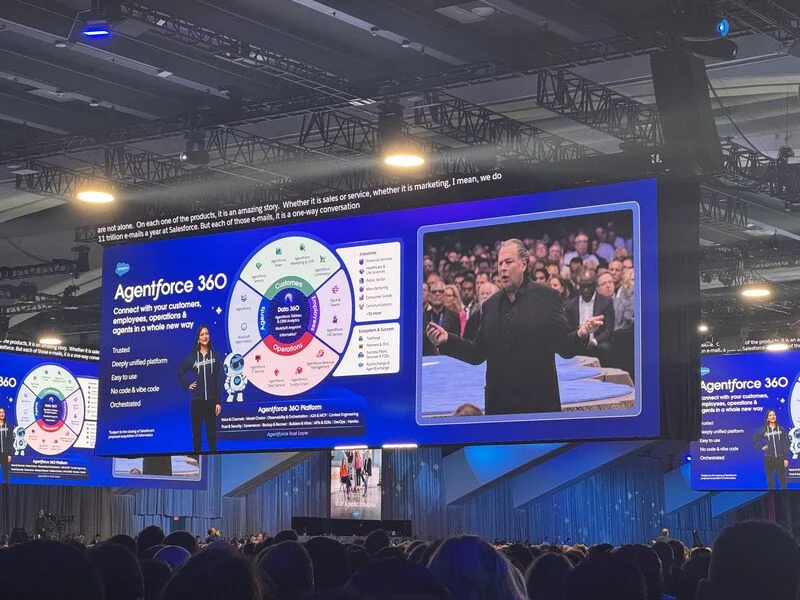
Our Comprehensive Guide to Salesforce Implementation: Part 2
14 Feb, 20245 minIn today's fast-paced business landscape, staying competitive and delivering exceptional cus...

In today's fast-paced business landscape, staying competitive and delivering exceptional customer experiences are paramount. Salesforce, the world's leading CRM platform, is a state-of-the-art tool that empowers organisations to achieve these goals. However, Salesforce implementations require more than simple software installations; they demand a strategic approach and a comprehensive plan.
In part one, we explore the various advantages that Salesforce can bring to your company, as well as the 3 primary types of Salesforce implementation. Here, in part two, we’ll provide you with a step-by-step roadmap to Salesforce implementation success. By following our expert guidance, your company will be well-equipped to ensure that your Salesforce rollout aligns with your goals and business objectives.
Our Step-By-Step Guide for Salesforce Implementation Success
Once you have decided which Salesforce implementation option works for your firm, you can start to prepare for setting your plan into action. As we alluded to in part one of our guide, rolling out Salesforce is no easy feat, and a failure to conduct a well-organised implementation process can have far-reaching and damaging consequences. In fact, according to Salesforce’s own website, the failure rate for CRM implementations is relatively high.
There are many reasons for this somewhat unwelcome trend, including a lack of a coherent CRM strategy, a focus on technology rather than people, and poor data quality. Despite these key concerns, there is plenty of reason to be optimistic about your Salesforce implementation, especially if you elect to utilise the services of an accomplished Salesforce implementation partner.
Let’s delve into the 8 steps you should follow to guarantee an efficient and effective Salesforce implementation process:
1. Outline Your Goals and Business Objectives
At the outset of any Salesforce rollout, establishing goals, business objectives, and KPIs is paramount. Whether your implementation is a success or not is contingent on whether it aligns with your organisation’s specific goals, so accurately determining what you wish to achieve is a key initial step. You should start by asking yourself various questions - Why are you incorporating Salesforce products into your operations? What do you want to accomplish? Are there any considerations you need to address?
Another handy tip is to ask each department to generate a list of the duties they perform and identify which could be streamlined via the Salesforce platform. Once you have outlined the key areas that could be improved by Salesforce’s powerful CRM, it would be useful to create a document that clearly communicates your goals and KPIs with staff. This will not only help you in setting priorities, but it will also make your team aware of your expectations and business objectives.
An important aspect of outlining your objectives is deciding which Salesforce products to use. To give you a sense of what the platform offers, here are 3 of the most common Salesforce products:
- Salesforce Sales Cloud. As Salesforce’s flagship product, Salesforce Sales Cloud is a CRM platform that assists sales teams in managing customer relationships, leads, and opportunities. This premium CRM software offers a wide variety of features designed to help sales personnel increase productivity and close more deals, such as lead scoring, forecasting, and opportunity tracking.
- Salesforce Service Cloud. If you are looking for software that can help you manage your customer service operations, Salesforce Service Cloud would be a suitable option. With features like customer self-service portals, case management, and knowledge base management, this customer service platform is effective in providing support for customers via multiple channels.
- Salesforce Marketing Cloud. Creating and executing powerful marketing campaigns can be a complex undertaking, and if you require support with your campaigns, Salesforce Marketing Cloud has you covered. Formerly known as ExactTarget, this marketing automation platform enables digital marketers to boost customer engagement and marketing ROI. It has an array of useful tools for social media marketing, marketing analytics, and email marketing.
As well as offering a range of products, Salesforce has an industry-leading business app marketplace called AppExchange, where companies can access a selection of third-party apps designed to enrich their Salesforce experiences. If you feel that your business would benefit from all of Salesforce’s core products, you should check out Salesforce Customer 360, an integrated CRM service that includes Sales Cloud, Service Cloud, and Marketing Cloud, as well as a range of AI-powered features.
2. Define Your Stakeholders and Assign Roles
Regardless of whether you are conducting an in-house, third-party, or hybrid Salesforce implementation, it is vital to define your stakeholders and assign roles to each member of your project team.
It is essential that you identify the people and bodies that have a keen interest in your Salesforce rollout’s success, as their specific requirements will need to be addressed at every stage of the project. You will need to keep them in the loop about any challenges you experience and the implementation-related issues you may encounter.
While the exact responsibilities may differ depending on the nature of the project, here is a list of common stakeholder roles involved in Salesforce implementations:
- Project Manager: Tasked with the overall planning and execution of the Salesforce implementation process, project managers are responsible for making sure that every element of the project is delivered on time and within budget. They must also guarantee that there is sufficient communication between stakeholders so that any concerns or issues can be addressed as early as possible.
- Business/ End Users: The business/ end users are the people who will be using the Salesforce system on a day-to-day basis. It is crucial for project managers to seek input from this group of individuals, not least to ensure that the system is user-friendly and meets the requirements of those who use it most.
- IT Department: When it comes to the technical side of Salesforce rollouts, IT departments are essential. They are tasked with duties that are integral to the success of Salesforce implementations, such as system integration, data migration, and cyber security.
- Executive Sponsor: Responsible for championing the implementation project, executive sponsors are key in ensuring that Salesforce rollouts run smoothly. They are tasked with providing the necessary resources and support to guarantee that a project achieves its intended goals.
3. Create a Detailed Project Plan
Once you have outlined your objectives, success metrics, and stakeholder roles, you can get on with creating a detailed project plan for your Salesforce rollout. Your plan should take an array of factors into account, the most important of which are timeline, prioritisation, and budget. For project scheduling, you should set up a timeline that plans out each of the key implementation phases, along with specific dates and allotted time for team meetings.
As well as creating a schedule, considering multiple scenarios for various project outcomes would also be a wise move. Be sure to consider the best-case, worst-case, and most likely scenarios to ensure that you are well-prepared for any eventuality. By not planning for the most pessimistic potential outcome, you may not be equipped to deal with implementation risks if and when they arise. Additionally, tasks should be divided into categories based on their priority; for example, ‘must-have’, ‘should-have’, and ‘nice-to-have’.
When it comes to planning your budget, there are various Salesforce costs to consider. For reference, the average cost of implementing Salesforce ranges from $75,000 to $200,000, though, of course, this is entirely dependent on the complexity and scale of the project.
Here are the most common costs associated with Salesforce rollouts:
- Salesforce licensing: Salesforce licensing costs depend on the edition and licence type of the product you're using. For the basic edition, the cost is $1,250 a month, whereas the most advanced version costs $40,000.
- Customisation: Factors such as custom-built functionality and data migration have a bearing on customisation expenses, but costs typically range between $15,000 and $150,000.
- User training: User training costs depend on how many people will be using the platform, but on average, training budgets tend to be anywhere from $2,000 to $10,000.
- Post-launch support: The amount you’ll pay for post-launch support depends on how long you require assistance from your provider. For example, if you need three months of post-launch support, you should expect to pay between $25,000 and $45,000.
4. Develop a Change Management Plan
With a solid idea of the Salesforce products you intend to use and how you intend to execute your rollout, it’s time to develop a change management plan to ensure that everyone is aligned with your organisation’s strategic objectives. Your change management plan document should accurately outline the actions that need to be taken to support employees and stakeholders in adapting to the new system.
The first step in creating a change management plan should be to perform a change readiness assessment. This evaluation will give you valuable insights into how well-prepared your organisation is for change, pinpointing potential risks and challenges you may have to deal with. Your change management plan must address three key areas: communication, resistance management, and training.
It is extremely important to be open and transparent with your staff at all stages of the implementation process, providing them with communication channels that allow them to voice concerns. If there is any resistance to change, you should listen to the questions raised and identify strategies for allaying concerns. Having a detailed training plan is also fundamental to change management - these plans usually consider the following:
- A list of team members who require training on the new Salesforce products
- The subjects that will be covered
- Whether the training will take place online, in-person, or at the participant’s own pace
Involving your employees at an early stage of the implementation process is an integral aspect of any change management strategy. You should actively seek out honest feedback from your staff by sending out surveys. This way, you’ll be able to get a sense of their willingness to adapt to change and how comfortable they are with working with a brand-new CRM system.
As you complete your preparation for your Salesforce implementation, be sure to refer back to part one of our guide to learn all about the primary implementation types to determine which would be the ideal option for your business.
5. Clean up and Migrate Your CRM Data
In steps 1 to 4, we covered all of the preparatory stages your business should follow to get your Salesforce implementation off to a winning start. Now it’s time to get into the technical aspects of your rollout, and we’ll begin with cleaning up and migrating your CRM data.
This is an essential step in the Salesforce implementation process, as failing to address the quality and integrity of your CRM data can cause inefficiencies and inaccuracies later on in your Salesforce journey. Incomplete data may lead to poor decision-making from sales and marketing staff, leading to unwelcome consequences like misguided strategies, missed opportunities, or even damaged customer relationships.
By ensuring that your CRM data is as clean, accurate, and consistent as possible, you’ll maximise your chances of forging long-lasting customer relationships and optimising your sales and marketing processes. Here are our top tips for cleaning CRM data before migration:
- Utilise data cleanup tools to remove errors and redundancies from your data
- Assess the quality of your data by conducting a data readiness evaluation
- Run duplicate reports to identify and remove redundant records
- Carry out ‘data decluttering’ - the deletion of unnecessary fields or information
Once you are confident that your CRM data is all in order, you can progress to the migration process. Let’s explore the key best practices for CRM data migration during Salesforce implementation:
- Select a suitable migration tool that is compatible with your legacy CRM system and Salesforce, such as Salesforce’s Data Import Wizard
- Migrate your data in stages rather than all at once, as this will give you time to address issues if and when they arise
- Pay close attention to the migration process to make sure that everything goes to plan
- Perform test migrations with a subset of your CRM data to identify and resolve any potential issues
6. Customise Your Salesforce Products
One of the key advantages of Salesforce products is that they can be customised as much as the user wishes. Tailoring the platform to best suit your requirements is a critical element of the implementation process, as doing so can improve the efficiency and productivity of your project. Research conducted by Nucleus Research found that 86% of consumers claim that personalisation plays a significant role in their CRM purchasing decisions, and fortunately, Salesforce’s limitless scope for customisation allows users to create new functionalities and modify them to align with their needs.
Salesforce customisation provides numerous advantages for the implementation team and the end-users. For the individuals overseeing Salesforce implementation, the platform’s customisable features allow them to build bespoke interactive reports and dashboards. Customising Salesforce also can enhance the user experience by creating custom portals with handy self-service options for employees, partners, and customers.
Before tailoring your Salesforce products to align with your needs, you should choose the right customisation tools. Here are the most common options:
- Lightning: A JavaScript framework used for developing reusable components for Salesforce, Lightning is one of the most effective customisation tools.
- Visualforce: Visualforce is a front-end programming language that shares some similarities with HTML, specifically designed for creating UI pages and components.
- Apex: Similar to Java and C#, Apex is a back-end programming language that allows for objects and user actions.
- SOQL (Salesforce Object Query Language): Purpose-built for querying data in Salesforce, SOQL is a programming language that has a lot in common with SQL (Structured Query Language).
7. Integrate and Test
Integrating and testing are vital components of your Salesforce implementation, as they ensure that your system works seamlessly with other applications and that your customisations are functioning as you intended. As they are iterative processes, integrating and testing should be revisited whenever you make changes to your Salesforce systems. By conducting frequent and rigorous testing of your Salesforce products, you’ll be able to make sure that your implementation meets your business needs and facilitates high-quality user experiences.
The first step for a successful integration is to identify the integration requirements and select appropriate methods. You need to determine which applications need to be integrated with your Salesforce products, gaining a robust understanding of the data flow and the specific occasions where integration is required. There is a range of integration options, including bulk APIs and SOAP APIs, and the option you select is dependent on your project.
When it comes to testing, be sure to create a non-production environment so you can evaluate the integration without interrupting your live Salesforce systems. There is an array of tests that you should carry out to make sure that everything works as intended, the most important of which include unit testing, performance testing, and security testing. Once you have determined that your Salesforce system is secure, reliable, and user-friendly, you can initiate your rollout.
8. Initiate Go-Live
We’ve reached the last step in our Salesforce implementation roadmap, and arguably, it is the most essential; initiating the go-live process. Deploying your Salesforce CRM involves transitioning from the planning and development phase to making the system live and operational for your users. Although this is the last step on our list, it by no means represents a final end to your Salesforce experience. Even after the launch, you should prepare an ongoing support plan to tackle maintenance and support issues whenever they arise.
Prior to deploying your Salesforce software, it is essential to make sure that your team is adequately trained. Without sufficient training, users will find it all the more challenging to use the platform effectively. A key form of training you should provide is user training, a coaching method that is designed for all users. Typically delivered by the project’s business analyst, user training is largely theoretical, and participants are usually taught in a lecture-style format. Another popular coaching method is known as ‘train-the-trainer’, a training style that involves hands-on training delivered by super users, those with the deepest knowledge of the platform.
When you reach the scheduled deployment date, it’s time to initiate go-live. This process may require you to perform a few last-minute tweaks, such as making changes to the configuration of your Salesforce products or importing the latest data. Post-deployment monitoring is crucial for ensuring the long-term success of your Salesforce rollout, so be sure to regularly assess the performance of your software. Salesforce has a reputation for being a dynamic, ever-evolving platform, and conducting post-launch reviews is an effective method of keeping up with the pace of change.
Key Takeaways from Our Salesforce Implementation Guide: Part Two
Behind every successful Salesforce implementation, there is a complex yet rewarding process that requires careful planning, strategic alignment, and a commitment to adapt to change. By following the step-by-step roadmap we've outlined in this guide, your organisation can navigate the complexities of Salesforce implementation with confidence.
By following our specialist guidance, you're better equipped to make your Salesforce implementation a success, enabling your organisation to leverage the full power of this state-of-the-art CRM platform. Remember that continuous improvement and adaptation are essential, and ongoing support and training will be crucial for long-term success.
With this knowledge, you can embark on your Salesforce journey with confidence and commitment to achieving your business objectives and delivering exceptional customer experiences.
Specialists in Salesforce Recruitment
As we’ve explored in our comprehensive, two-part guide, Salesforce provides a myriad of important benefits, and getting the implementation process right is a must. To make sure that your organisation’s Salesforce implementation runs without any hitches, it is important to hire the best and brightest candidates to support you in that task.
As an award-winning agency with specialist knowledge of the salesforce recruitment space, we will go above and beyond to connect you with professionals with the skills to get your Salesforce journey off to a great start.
Reach out to us today to learn more about how we can help you with your Salesforce recruitment needs.


